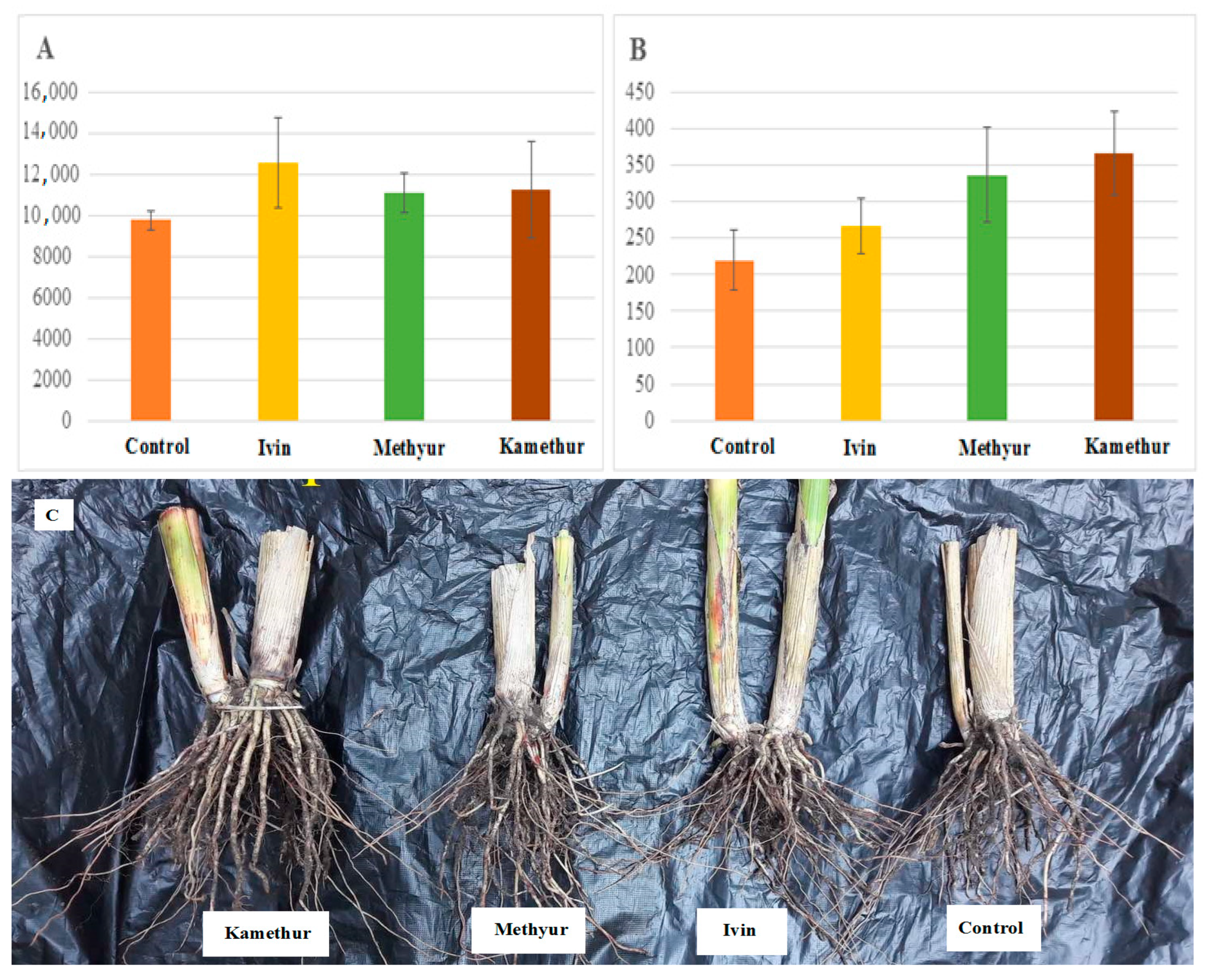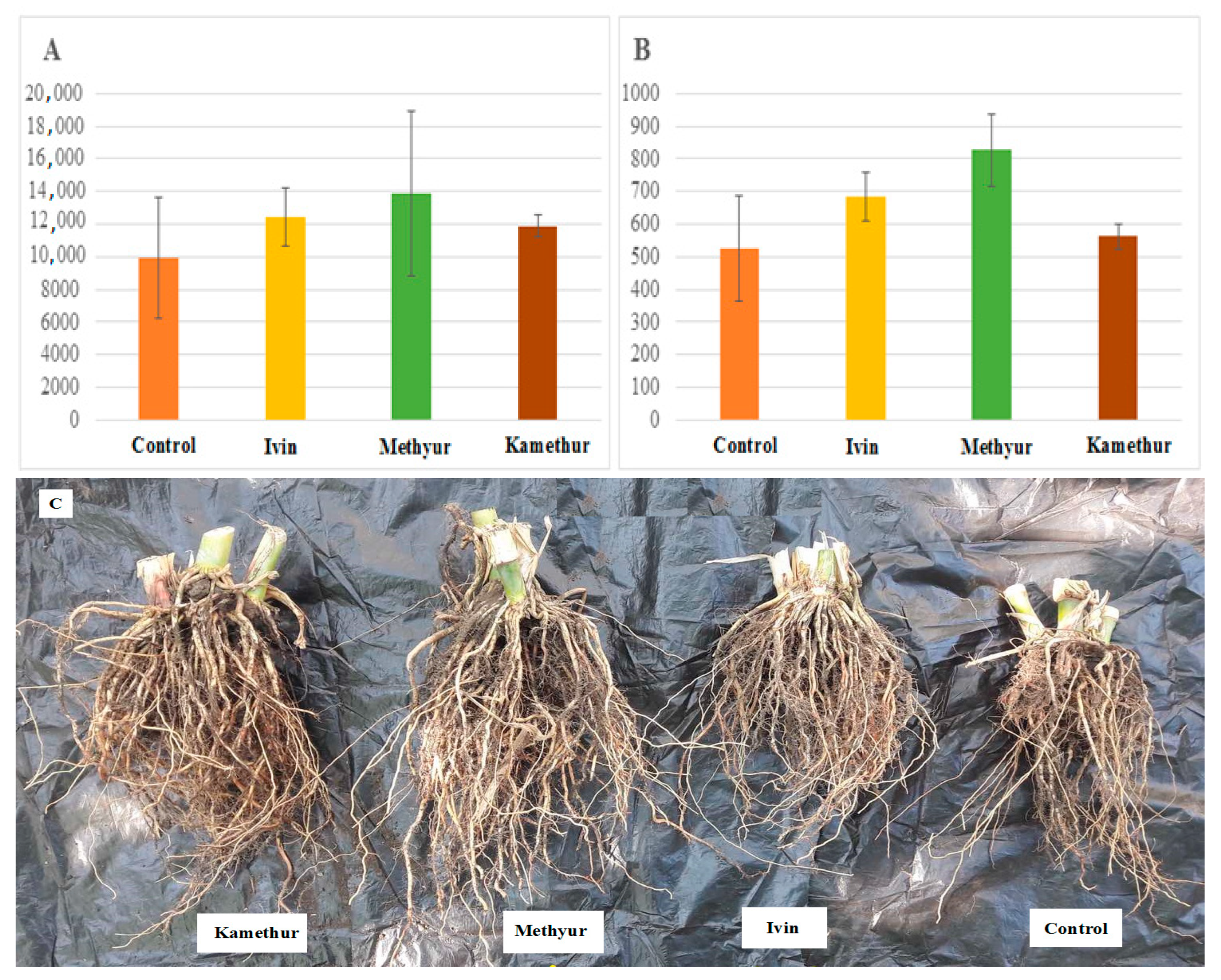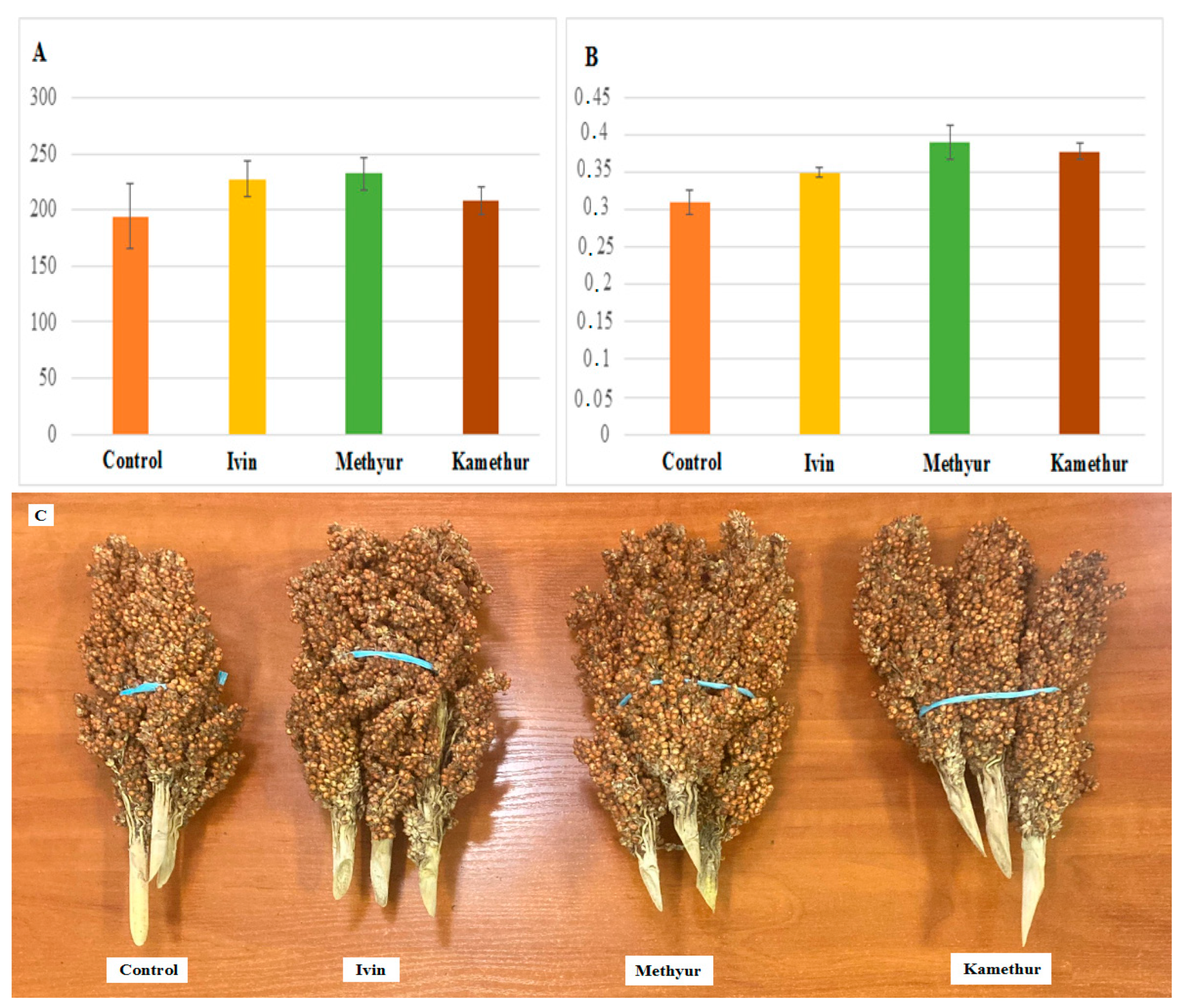Enhancing Sorghum Productivity with Methyur, Kamethur, and Ivin Plant Growth Regulators †
Abstract
:1. Introduction
2. Materials and Methods
3. Results
3.1. Study of the Effect of Plant Growth Regulators on Sorghum Growth
3.2. Study of the Effect of Plant Growth Regulators on Sorghum Yield
4. Conclusions
Author Contributions
Funding
Institutional Review Board Statement
Informed Consent Statement
Data Availability Statement
Conflicts of Interest
References
- Aruna, C.; Visarada, K.B.R.S.; Bhat, B.V.; Tonapi, V.A. (Eds.) Breeding Sorghum for Diverse End Uses. In Woodhead Publishing Series in Food Science, Technology and Nutrition, 1st ed.; Elsevier Ltd.: London, UK, 2018; 450p. [Google Scholar]
- Mundia, C.W.; Secchi, S.; Akamani, K.; Wang, G.A. Regional Comparison of Factors Affecting Global Sorghum Production: The Case of North America, Asia and Africa’s Sahel. Sustainability 2019, 11, 2135. [Google Scholar] [CrossRef]
- Kidanemaryam, W. Review on Mechanisms of Drought Tolerance in Sorghum (Sorghum bicolor (L.) Moench) Basis and Breeding Methods. Acad. Res. J. Agri. Sci. Res. 2019, 7, 87–99. [Google Scholar]
- Macedo, W.R.; Araujo, D.K.; Santos, V.M.; Castro, P.R.C.; Fernandes, G.M. Plant growth regulators on sweet sorghum: Physiological and nutritional value analysis. Comun. Sci. 2017, 8, 170–175. [Google Scholar] [CrossRef]
- Li, H.; Wang, X.L.; Guo, X.Q.; Rao, M.; Steinberger, Y.; Cheng, X.; Xie, G.H. Effects of plant growth regulators on growth, yield and lodging of sweet sorghum. Res. Crops 2011, 12, 372–382. [Google Scholar]
- Tsygankova, V.A.; Voloshchuk, I.V.; Klyuchko, S.V.; Pilyo, S.G.; Brovarets, V.S.; Kovalenko, O.A. The effect of pyrimidine and pyridine derivatives on the growth and productivity of sorghum. Int. J. Bot. Stud. 2022, 7, 19–31. [Google Scholar]
- Voytsehovska, O.V.; Kapustyan, A.V.; Kosik, O.I.; Musienko, M.M.; Olkhovich, O.P.; Panyuta, O.O.; Parshikova, T.V.; Glorious, P.S. Plant Physiology: Praktykum; Parshikova, T.V., Ed.; Teren: Lutsk, Ukraine, 2010; 420p. [Google Scholar]
- Bang, H.; Zhou, X.K.; van Epps, H.L.; Mazumdar, M. Statistical Methods in Molecular Biology. In Series: Methods in Molecular Biology; Humana Press: New York, NY, USA, 2010; Volume 13, 636p. [Google Scholar] [CrossRef]
- Lavy, M.; Estelle, M. Mechanisms of auxin signaling. Development 2016, 143, 3226–3229. [Google Scholar] [CrossRef] [PubMed]
- Kieber, J.J.; Schaller, G.E. Cytokinin signaling in plant development. Development 2018, 145, dev149344. [Google Scholar] [CrossRef] [PubMed]
- Tsygankova, V.A.; Andrusevich, Y.V.; Shtompel, O.I.; Solomyanny, R.M.; Hurenko, A.O.; Frasinyuk, M.S.; Mrug, G.P.; Shablykin, O.V.; Pilyo, S.G.; Kornienko, A.M.; et al. New Auxin and Cytokinin Related Compounds Based on Synthetic Low Molecular Weight Heterocycles. In Auxins, Cytokinins and Gibberellins Signaling in Plants. Signaling and Communication in Plants; Aftab, T., Ed.; Springer Nature Switzerland AG: Berlin/Heidelberg, Germany, 2022; Chapter 16; pp. 353–377. [Google Scholar] [CrossRef]
- Tsygankova, V.A.; Blyuss, K.B.; Shysha, E.N.; Biliavska, L.A.; Iutynska, G.A.; Andrusevich, Y.V.; Ponomarenko, S.P.; Yemets, A.I.; Blume, Y.B. Using microbial biostimulants to deliver RNA interference in plants as an effective tool for biocontrol of pathogenic fungi, parasitic nematodes and insects. In Research Advances in Plant Biotechnology. Series: Plant Science Research and Practices; Blume, Y.B., Ed.; Nova Science Publishers, Inc.: New York, NY, USA, 2020; Chapter 6; pp. 205–319. [Google Scholar]
- Pidlisnyuk, V.; Mamirova, A.; Newton, R.A.; Stefanovska, T.; Zhukov, O.; Tsygankova, V.; and Shapoval, P. The role of plant growth regulators in Miscanthus × giganteus utilisation on soils contaminated with trace elements. Agronomy 2022, 12, 2999. [Google Scholar] [CrossRef]
- Bilyavska, N.O.; Voloshina, N.Y.; Topchii, N.M.; Konturska, O.O.; Palladina, T.O. Effects of salt and osmotic stresses and Methyure on foliar photosynthetic apparatus in maize. Bull. Kharkiv Natl. Agrar. Univ. Ser. Biol. 2009, 3, 35–42. [Google Scholar]
- Palladina, T.O.; Ribchenko, Z.I.; Konturska, O.O. Dependence of preparation Metiure adaptogenic effect on plants under salt stress conditions from its molecular structure. Biotechnol. Acta 2012, 5, 115–120. [Google Scholar]
- Rudnytska, M.V.; Palladina, T.A. Effect of preparations Methyur and Ivine on Ca2+-ATPases activity in plasma and vacuolar membrane of corn seedling roots under salt stress conditions. Ukr. Biochem. J. 2017, 89, 76–81. [Google Scholar] [CrossRef] [PubMed]





Disclaimer/Publisher’s Note: The statements, opinions and data contained in all publications are solely those of the individual author(s) and contributor(s) and not of MDPI and/or the editor(s). MDPI and/or the editor(s) disclaim responsibility for any injury to people or property resulting from any ideas, methods, instructions or products referred to in the content. |
© 2023 by the authors. Licensee MDPI, Basel, Switzerland. This article is an open access article distributed under the terms and conditions of the Creative Commons Attribution (CC BY) license (https://creativecommons.org/licenses/by/4.0/).
Share and Cite
Tsygankova, V.A.; Voloshchuk, I.V.; Pilyo, S.H.; Klyuchko, S.V.; Brovarets, V.S. Enhancing Sorghum Productivity with Methyur, Kamethur, and Ivin Plant Growth Regulators †. Biol. Life Sci. Forum 2023, 27, 36. https://doi.org/10.3390/IECAG2023-15222
Tsygankova VA, Voloshchuk IV, Pilyo SH, Klyuchko SV, Brovarets VS. Enhancing Sorghum Productivity with Methyur, Kamethur, and Ivin Plant Growth Regulators †. Biology and Life Sciences Forum. 2023; 27(1):36. https://doi.org/10.3390/IECAG2023-15222
Chicago/Turabian StyleTsygankova, Victoria Anatolyivna, Iryna Valeriivna Voloshchuk, Stepan Hryhorovych Pilyo, Svitlana Viktorivna Klyuchko, and Volodymyr Serhiyovych Brovarets. 2023. "Enhancing Sorghum Productivity with Methyur, Kamethur, and Ivin Plant Growth Regulators †" Biology and Life Sciences Forum 27, no. 1: 36. https://doi.org/10.3390/IECAG2023-15222
APA StyleTsygankova, V. A., Voloshchuk, I. V., Pilyo, S. H., Klyuchko, S. V., & Brovarets, V. S. (2023). Enhancing Sorghum Productivity with Methyur, Kamethur, and Ivin Plant Growth Regulators †. Biology and Life Sciences Forum, 27(1), 36. https://doi.org/10.3390/IECAG2023-15222





